www.chechurubiera.info - an online magazine for fans of Chechu Rubiera
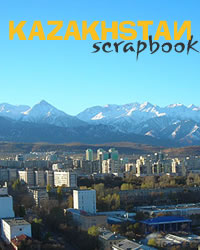
KAZAKHSTAN
AT A GLANCE
population: 15.4 million
capital: Astana
largest city: Almaty
area: 2.7 million sq km
major languages: Kazakh, Russian
major religions: Islam, Christianity
money: Kazakh tenge
main exports: Oil, uranium, ferrous and nonferrous metals, machinery, chemicals, grain, wool, meat, coal
internet domain: .kz
ASTANA
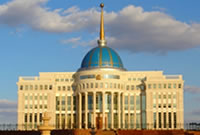
The Presidential Palace
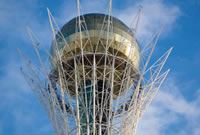
The Baiterek, symbol of new Astana
NUCLEAR FREE
Following fives years of talks, Kazakhstan, Kyrgyzstan, Tajikistan, Turkmenistan, and Uzbekistan agreed the text of a treaty establishing a Central Asian nuclear weapon-free zone in 2002.
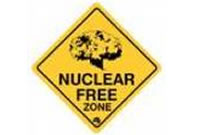
It led the way for the creation of the world’s fifth nuclear weapon-free zone.
In Soviet times, atomic and hydrogen bomb testing took place on the steppes of Kazakhstan.
EXILE
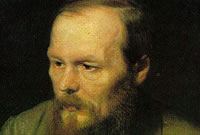
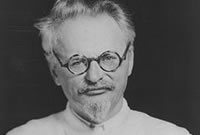
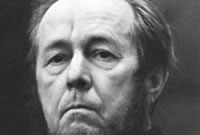
Fyodor Dostoevsky, Leon Trotsky and Aleksander Solzhenitsyn were all exiles, forced to spend time in Kazakhstan.
After his release from four year hard labour, Dostoevsky was required to servie in the Siberian Regiment, stationed in Kazakhstan.
An influential politician in the early days of the Soviet Union, Trotsky was expelled after leading a revolt against the rise of Joseph Stalin.
Solzhenitsyn was sent to Ekibastuz, north-east of Astana in 1950, to a special camp for political prisoners. In 1953, he was sentenced to interal exile in Kok-Terek, southern Kazakhstan.
According to Christopher Robbins, Solzhenitsyn is a much disliked figure in Kazakhstan, as he has regularly stated that much of Kazakh territory rightly belongs to Russia.
KAZAKHSTAN
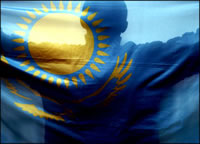 As Europe's boundary stretches ever eastwards, most of us know so little about the new independent states of the old Soviet Union.
As Europe's boundary stretches ever eastwards, most of us know so little about the new independent states of the old Soviet Union.
Some of these states are neighbours and are already considered part of New Europe. Ukraine, Estonia, Latvia, Lithuania, even Russia itself.
Further east still, bordering on China, the Republic of Kazakhstan has demanded the world's attention.
Once the dumping ground for Stalin's vicious deportation programme, Kazakhstan is a harmonious, multicultural society today. And it is booming.
Phenomenal natural resources of oil, gas, coal, copper, uranium, platinum and gold have brought extreme wealth to Kazakhstan. They've built a shiny new capital in the middle of the unforgiving steppe lands. Astana is the symbol of new, wealthy, independent Kazakhstan.
Yet Kazakh history is long, its ancient culture and landscape defines modern Kazakh life. It's an intriguing and hopeful story.
INTRODUCTION
Modern Kazakhstan occupies a region of central Asia that is shrouded in mystery.
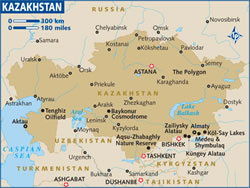 Closed to foreign visitors in the nineteenth century, and sealed tight by the Soviets, Kazakhstan disappeared from awareness of most Westerners.
Closed to foreign visitors in the nineteenth century, and sealed tight by the Soviets, Kazakhstan disappeared from awareness of most Westerners.
Yet it is a vast country, occupying a region of Central Asia, bordering on China. The flight from London to the old capital Almaty takes eight hours, four crossing Europe, four to cross Kazakhstan.
Landscape
The landscape is magnificent, unspoilt and unpeopled. The Kazakh steppe is a great sea of grass, vaster than the American prairie or the Argentine pampas. Nomads have lived on the steppe for thousands of years, here you'll find the heart of their culture.
The varied landscape stretches from the mountainous, heavily populated regions of the east to the sparsely populated, energy-rich lowlands in the west, and from the industrialised north, with its Siberian climate and terrain, through the arid, empty steppes of the centre, to the fertile south.
Kazakhstan has emerged from seventy years of Soviet rule as vibrant, modern state. It is extremely wealthy, there are vast resources of minerals - coal, copper, uranium, platinum, gold and of course, oil. Beneath the Caspian Sea, there lies a quarter of the planet's remaining oil reserves.
Since independence, there has been major foreign investment in the Caspian oil sector. Oil development has brought rapid economic growth.
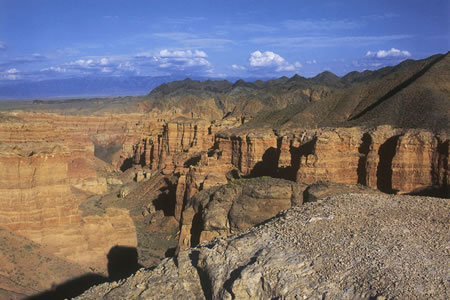 Red Canyon in Kazakhstan, through which the Charyn river flows
Red Canyon in Kazakhstan, through which the Charyn river flows
The people
Ethnically, the country is as diverse as the landscape, with the Kazakhs making up over half the population, the Russians comprising just over a quarter, and smaller minorities of Ukrainians, Germans, Chechens, Kurds, Koreans and Central Asian ethnic groups accounting for the rest.
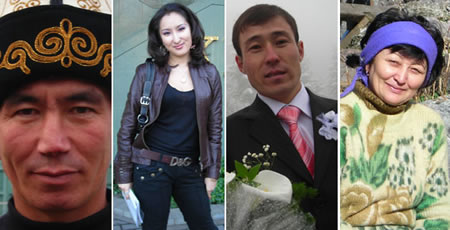
Ethnic Kazakhs are descended from Turkic and other nomadic tribes which came to the region in the 13th century. Today Kazakhs can also be found in China, Mongolia, Russia, Ukraine, Iran and Afghanistan.
We're working on it next! Politics. Architecture.
READ THIS
IN SEARCH OF KAZAKHSTAN, THE LAND THAT DISAPPEARED
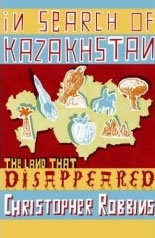 “Kazakhstan is the ninth largest country in the world, the size of the whole of Western Europe, although few people know where it is or anything about it. That was before Borat. Now suddenly everybody has heard of Kazakhstan - and knows even less about it, and are still unable to place it on a map.”
“Kazakhstan is the ninth largest country in the world, the size of the whole of Western Europe, although few people know where it is or anything about it. That was before Borat. Now suddenly everybody has heard of Kazakhstan - and knows even less about it, and are still unable to place it on a map.”
Author Christopher Robbins' great gift is to say things simply.
From his visit to the Soviet rocket launch site, to conversations with the President, Robbins' stories are personal and intriguing.
The Kazakh people are immensely proud and endlessly hospitable. They have a vast new wealth, and so for the first time, power in the world, reflected in the new gesture architecture of the new capital city.
Robbins adds colour to the endless, unforgiving landscape, where the summer heat and the winter cold are extremes beyond the experience of Western Europeans.
This is a easy book with hidden depths. You'll be tempted to find out more about this country, if not to get on a plane and go. You'll want to see the original wild apple orchards and the beautiful mountains, to smell the crushed wormwood, and wonder at the much reduced Aral Sea. President Nazarbayev's utopian glass pyramid must be seen, it's the centre-piece of a multi-ethnic, multi-religion Kazakhstan.
There are also reminders of a different life, the totalitarian life of the Gulag, nuclear testing, heavy industry and a displaced people. All these these are gone, but not forgotten in Kazakhstan.
For an extract, see IN SEARCH OF KAZAKHSTAN WEBSITE
In English only, this book will be published in the US in April 2008. Meantime, you can buy a copy on AMAZON UK for £7.79 (normally £12.99).
We're also reading Once in Kazakhstan : The Snow Leopard Emerges by Keith Rosten and Colin Thubron's Shadow of the Silk Road (not specifically about Kazakhstan, but a great excuse to read Thubron again).
APPLES COME FROM KAZAKHSTAN
Kazakhstan is the birthplace of the apple.
An age old argument about its origin - perhaps it was Roman, or Celtic or Nordic - was finally setteled by Nikolai Vavilov, Russian geneticist and one of the greatest Soviet scientists.
He identified the origin of more plants than anyone in history. When he arrived in the Almaty region, it seemed that the whole area was one great orchard, covered in forests with every variety of wild apples. Almaty means "appleness" in Kazakh.
It is said that apples grown in the Almaty region of Kazakhstan can weigh more than a kilogram.
You might like to know that Kazakhstan is also the birthplace of the tulip, and is home to thirty of the world's eighty species.
FAMOUS KAZAKHS
Wikipedia delivers a formidable list of unknown and unpronouncable famous Kazakhs, such as Rayimbek, an 18th-century Kazakh warrior; Abay Kunanbayev, the 19th-century poet, composer and educator and Alexander Vinokourov, (ex)cyclist.
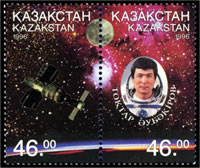 But for me, the best has to be Toktar Aubakirov, the first Kazakh in space.
But for me, the best has to be Toktar Aubakirov, the first Kazakh in space.
(This is perhaps because I once chaperoned the very wonderful Valentina Tereshkova, first woman in space.)
In 1991, Aubakirov launched in Soyuz TM-13 from the Baikonur Cosmodrome spaceport (in central Kazakhstan), and spent over eight days in space.
He was the first Soviet citizen to go into space without being fully certified as a cosmonaut.